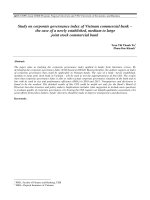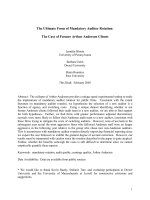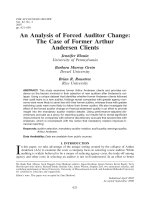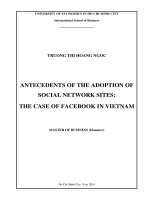Factors influencing farmers purchase behavior the case of UZ45 in lam dong province
Bạn đang xem bản rút gọn của tài liệu. Xem và tải ngay bản đầy đủ của tài liệu tại đây (1.22 MB, 115 trang )
FACTORS INFLUENCING FARMERS' PURCHASE BEHAVIOR – THE
CASE OF UZ45 IN LAM DONG PROVINCE
In Partial Fulfillment of the Requirements of the Degree of
MASTER OF BUSINESS ADMINISTRATION
In Marketing
By
Mr: Nguyen Gia Thinh
ID: MBA04037
International University - Vietnam National University HCMC
August 2013
FACTORS INFLUENCING FARMERS' PURCHASE BEHAVIOR – THE CASE OF
UZ45 IN LAM DONG PROVINCE
In Partial Fulfillment of the Requirements of the Degree of
MASTER OF BUSINESS ADMINISTRATION
In Marketing
By
Mr: Nguyen GIA THINH
ID: MBA04037
International University - Vietnam National University HCMC
August 2013
Under the guidance and approval of the committee, and approved by all its members, this thesis
has been accepted in partial fulfillment of the requirements for the degree.
Approved:
---------------------------------------------Chairperson
--------------------------------------------Advisor
---------------------------------------------Committee member
--------------------------------------------Committee member
---------------------------------------------Committee member
--------------------------------------------Committee member
i
Acknowledge
I would like to thank a lot to Prof. Le Nguyen Hau, School of Industrial
Management, HCMC University of Technology, for your patience, helpful advices
and consults.
I also remember in mind the contribution from lecturers of International
University – National University HCMC.
For my family, my company and my customers, thank you so much for your
support.
ii
Plagiarism Statements
I would like to declare that, apart from the acknowledged references, this
thesis either does not use language, ideas, or other original material from anyone; or
has not been previously submitted to any other educational and research programs or
institutions. I fully understand that any writings in this thesis contradicted to the
above statement will automatically lead to the rejection from the MBA program at
the International University – Vietnam National University Hochiminh City.
iii
Copyright Statement
This copy of the thesis has been supplied on condition that anyone who
consults it is understood to recognize that its copyright rests with its author and that
no quotation from the thesis and no information derived from it may be published
without the author’s prior consent.
© Nguyen Gia Thinh/MBA04037/2013
iv
Table of Contents
Abstract ........................................................................................................................ x
CHAPTER ONE – INTRODUCTION ..................................................................... 1
1.
Research Background ..................................................................................... 1
2.
Statement of the Problem ............................................................................... 4
3.
Research Objective.......................................................................................... 5
4.
Significance of the Research ........................................................................... 5
5.
Research Scope ................................................................................................ 5
6.
Limitation of the Research ............................................................................. 5
CHAPTER TWO – LITERATURE REVIEW ........................................................ 6
1.
Theory Review ................................................................................................. 6
1.1.
Theory of Reasoned Action ......................................................................... 6
1.2.
Theory of Planned Behavior ........................................................................ 7
1.3.
Technology Acceptance Model .................................................................... 9
1.4.
Model of Consumer Decision Making ...................................................... 10
2.
The Proposal Framework ............................................................................. 12
2.1.
Components of TRA Model ....................................................................... 14
2.1.1.
Behavior............................................................................................... 14
2.1.2.
Intention .............................................................................................. 14
2.1.3.
Attitude................................................................................................. 15
v
2.1.4.
Salient Belief ....................................................................................... 16
2.1.5.
Subjective Norm .................................................................................. 17
2.1.6.
Normative Belief.................................................................................. 17
2.2.
Relation among TRA’s Components ........................................................ 18
2.2.1.
Behavior, Intention, Attitude and Subjective Norm .......................... 18
2.2.2.
Attitude and Behavioral Belief ........................................................... 19
2.2.3.
Subjective Norm and Normative Belief .............................................. 20
3.
Previous Studies ............................................................................................ 20
4.
Research Model and Hypothesis .................................................................. 22
CHAPTER THREE – RESEARCH DESIGN........................................................ 27
1.
Qualitative Research ..................................................................................... 27
2.
Quantitative Research .................................................................................. 27
2.1.
Sampling Procedure ................................................................................... 27
2.2.
Measurement Scales ................................................................................... 27
2.3.
Questionnaire .............................................................................................. 30
2.4.
Data Analysis .............................................................................................. 31
CHAPTER FOUR – RESULT ................................................................................. 32
1.
Result of Qualitative Study .......................................................................... 32
2.
Sample Description ....................................................................................... 33
2.1.
Age ............................................................................................................... 33
2.2.
Gender ......................................................................................................... 33
vi
2.3.
Education .................................................................................................... 33
2.4.
Farm Area ................................................................................................... 33
2.5.
Farming Experience ................................................................................... 34
2.6.
Crop ............................................................................................................. 34
2.7.
Selling Price of Farming Products ............................................................ 34
2.8.
Payment Term of Purchasing Pesticides Product ................................... 34
2.9.
Weather ....................................................................................................... 35
2.10.
3.
Income ...................................................................................................... 35
Data Screening............................................................................................... 35
3.1.
Multivariate normality ............................................................................... 35
3.2.
Outliner ....................................................................................................... 37
3.2.1.
Univariate outliner. ............................................................................. 37
3.2.2.
Multivariate Outliner .......................................................................... 38
4.
Measurement Model ..................................................................................... 39
4.1.
Specification ................................................................................................ 39
4.2.
Re-specifying Record ................................................................................. 41
4.3.
Identification ............................................................................................... 42
4.4.
Construct Reliability and Validity ............................................................ 43
4.4.1.
Reliability ............................................................................................. 43
4.4.2.
Validity ................................................................................................. 43
4.5.
Testing Measurement Model ..................................................................... 46
vii
5.
Structural Model ........................................................................................... 48
5.1.
Specification ................................................................................................ 48
5.2.
Identification ............................................................................................... 50
5.3.
Testing Structural Model ........................................................................... 51
6.
Hypothesis Testing ........................................................................................ 52
7.
Discussion ....................................................................................................... 55
7.1.
Attitude, Subjective Norm and Consumption Level ............................... 56
7.2.
Belief about Quality, Belief about Cost and Attitude .............................. 57
7.3.
Belief about Quality, Normative from Colleague and Retailer .............. 58
7.4.
Normative Belief from Colleague, Retailer and Subjective Norm ......... 58
7.5.
Application – Marketing Plan for UZ45 .................................................. 60
7.5.1.
Positioning........................................................................................... 60
7.5.2.
Marketing Mix .................................................................................... 61
7.5.3.
Integrated Marketing Communication ............................................ 62
CHAPTER FIVE – CONCLUSION ....................................................................... 65
1.
Conclusion...................................................................................................... 65
2.
Suggestion for Managers .............................................................................. 65
3.
Limitation ...................................................................................................... 66
References .................................................................................................................. 68
Appendixes ................................................................................................................. 70
viii
List of Tables
Table 1: Overall Measurement Scale ......................................................................... 29
Table 2: Skew and Kurtosis Index ............................................................................. 36
Table 3: Observed Variables Contain Potential Outliners ......................................... 37
Table 4: Mutivariate Outliners ................................................................................... 39
Table 5: Reliability of Scales ..................................................................................... 43
Table 6: Standardized Regression Weights (Factor Loadings) .................................. 44
Table 7: Correlation ................................................................................................... 45
Table 8: Fit Indices - Measurement Model ................................................................ 48
Table 9: Goodness of Fit Indices - Structural Model ................................................. 51
Table 10: Unstandardized Regression Weights - Structural Model ........................... 52
Table 11: Standardized Regression Weights - Structural Model ............................... 53
Table 12: Covariance and Correlation ....................................................................... 55
ix
List of Figures
Figure 1: Global Pesticide Trading Value 2005-2011. ................................................ 1
Figure 2: Pesticide Import Value of Vietnam 2008-2012 ............................................ 2
Figure 3: Sales History of UZ45 2008-2012 ................................................................ 3
Figure 4: Growth rate of UZ45 2008-2012 .................................................................. 4
Figure 5: Theory of Reasoned Action Diagram. .......................................................... 7
Figure 6: Theory of Planned Behavior Diagram .......................................................... 8
Figure 7: Technology Acceptance Model .................................................................... 9
Figure 8: A Model of Consumer Decison Making..................................................... 11
Figure 9: Proposed Research Model .......................................................................... 24
Figure 10: Measurement Model ................................................................................. 40
Figure 11: Structural Model ....................................................................................... 49
x
Abstract
To understand consumers’ purchase behavior in the case of product UZ45
(fungicide) in Lam Dong province, based on Theory of Reasoned Action, researcher
proposed research model and hypotheses. Measurement scales were developed to
measure constructs. Full measurement model was tested by CFA procedure. Then,
structural equation model was tested. Models fit the data well. Proposed hypotheses
were supported and interpreted. Factors influencing consumers’ purchase behavior
includes consumers’ attitude toward consuming UZ45, consumers’ belief about
UZ45’s quality and price, subjective norm, normative belief from colleague and
normative belief from retailer. Among them, consumers’ attitude toward consuming
UZ45, consumers’ belief about UZ45’a quality and normative belief from colleague
are more important factors. Consumers’ attitude toward using the product impacts
stronger on consuming behavior than subjective norm. Consumers’ belief about
product’s quality influences stronger on consumers’ attitude toward using product
than consumers’ belief about product’s price. Normative belief from colleague
affects stronger on subjective norm than normative belief from retailer. It also impact
consumer’s belief about product’s quality and price.
The research then suggested that in order to increase sales of UZ45, the
company should position on consumer mind that the product is good quality and on
retailers’ mind that UZ45 is a profitable product. Some features were suggested to be
included in the product such as solubility, sticky and fungi control. The research also
mentioned the possibility of increase consumers’ price to fund communication.
Retailers’ profit was also noted as an issue in distribution channel. An integrated
marketing communication strategy was suggested. Marketing activities should focus
more on farmer than retailer because farmer can affect other farmers better.
Advertising and event were suggested to communicate to farmers. A farmer can be
considered as a good spoken person in the communication plan because he can
influence well consumers’ perception about quality. But care also should be spent to
retailers because they indirectly affect consumers’ attitude, perception about quality
and cost beside direct effect on subjective norm. Trade promotion is the
recommended tool to communicate with retailers.
xi
This page is intentionally left blank
1
CHAPTER ONE – INTRODUCTION
1. Research Background
From the time when the first pesticide was used in around 1000 BC, the global
pesticide industry trading value was worth more than 23 billion USD in 2011 (FAO
statistic, 2013). The global trading value increased continuously from 16 billion USD
in 2005 to 25 billion USD in 2008, then faced a little bid fluctuation from 2009 to
2011 as shown in Figure 1. In 2011, France, Germany and USA are three largest
pesticide exporters in the world.
Global Pesticide Trading Value 2005-2011 (Million USD)
25,065
16,516
2005
24,608
23,411
20,114
23,469
16,509
2006
2007
2008
2009
2010
2011
Figure 1: Global Pesticide Trading Value 2005-2011.
(Source: FAO statistic, 2013)
In 2010, Vietnam was one of 14 largest pesticides import country in the
world (FAO Statistic, 2013). As shown in Figure 2, annual pesticide import value of
Vietnam continuously increases in 2009-2011 period. In 2012, the import value
reaches 745 million USD, a little lower than 2011. There are totally 1,405 active
ingredients and 3,514 brand names and around 200 companies operating in this
market (Circular No.10/2012-NN-PTNN, Vietnam government 2012).
2
Vietnam Pesticides Import Value 2008-2012 (Mil USD)
752
745
2011
2012
577
541
521
2008
2009
2010
Figure 2: Pesticide Import Value of Vietnam 2008-2012
(Source: A&A Co,.Ltd)
Joined Vietnam pesticide market from 2002, A&A Co,.Ltd1 – an Indian
company has been developing sustainably with annual growth rate exceeding 20%. It
possessed a rich product portfolio consisting of herbicides, insecticides and
fungicides. Its key fungicide is Mancozeb.
Mancozeb is a complex of zinc and maneb containing 20% Mn and 2.5% Zn
(FAO specification No.34/1/ts/9, 1980). It has been used as an active ingredient to
control harmful fungi named as Phytophthora infestansa which cause Downy
Mildew disease in tomato and potato. It is an off-patent chemical product so that
every company can manufacture it as long as they have enough technological
capacity to do. Because many companies produce and sell Mancozeb, they have to
use a brand name to distinguish their product from other competitors. For example,
Mancozeb brand name of Dow Agrochem Company (USA) is Dithane and A&A
Company’s Mancozeb brand name is UZ452.
(1). Company name A&A has been changed for confidential purpose.
(2). Product name UZ45 has been changed for confidential purpose.
3
Launched in 2008, UZ45 has grown impressively in the first three years as
shown in Figure 3. In last 2 years, although its sales increased year by year, the
growth rate has tended to decrease and toughed 7% in 2011 and 3% in 2012 as
shown in Figure 4.
UZ45 Sales History 2008-2012 (Ton)
150
140
155
120
80
2008
2009
2010
2011
2012
Figure 3: Sales History of UZ45 2008-2012
(Source: A&A Co.,Ltd, 2013)
Currently, the company’s marketing plan for UZ45 is spread and just based
on subjective assumptions instead of confirmed facts. The word “spread” here briefly
described how the company is allocating marketing efforts. They are positioning that
UZ45 is both high quality and reasonable cost because they don’t know between
quality and cost, which one is more valuable to consumers. They are dividing some
budget for consumer’s promotion and some for retailer’s discount because they don’t
have evidence that is reliable to be sure that who is more important between
consumers and retailers.
“Successful marketing builds demand for products and services” (Kotler &
Keller, 2012, p.4). The decrease of sales growth rate mentioned above changes
4
approach of board of director. They decide that this is the time for developing a
better and more structural marketing plan for UZ45 so that marketing efforts can be
allocated rightly to enhance sales of the product.
UZ45 Growth Rate History 2008-2012 (%)
50%
17%
7%
0%
2008
3%
2009
2010
2011
2012
Figure 4: Growth rate of UZ45 2008-2012
(Source: A&A Co.,Ltd, 2013)
Kotler and Keller (2012) also argued that successful marketing requires that
companies fully connect with their customers, understand customers a 360-degree
view of both their daily lives and the changes that occur during their lifetimes so the
right products are always marketed to the right customers in the right way. So, in
order to develop a better marketing plan for UZ45, a research on consumers’
behavior accounts for a crucial role.
2. Statement of the Problem
The existing marketing plan is no longer appropriate in supporting sales development
of UZ45. The company requests a better and more structural marketing plan so that
they can allocate accurately marketing resources to maintain and increase the
5
product’s sales. A deep insight of consumer purchase behavior accounts for a crucial
role in this mission.
3. Research Objective
The research is aimed to find out main factors influencing farmers’ purchase
behavior in the case of product UZ45 in Lam Dong province and suggest marketing
strategy to managers to develop the product’s sales.
4. Significance of the Research
Knowing main factors influencing consumers’ purchase behavior will help managers
to allocate rightly marketing efforts to maintain and grow sales of the product. For
instance, if finally the research finds that consumers’ buying behavior is affected
more strongly by normative belief from important others rather than his own beliefs,
the company’s marketing communication campaign should set his important others
as targeted audiences instead of himself.
5. Research Scope
This research is carried out within Lam Dong province where accounts for 80% sales
of UZ45 in Vietnam market. The population is defined as a set of farmers who have
demand of Mancozeb products, within Lam Dong province and no matter what brand
he/she is familiar with.
6. Limitation of the Research
Findings from this research can be generalized to explain purchase behavior of
famers in Lam Dong province and in case of UZ45 product only.
6
CHAPTER TWO – LITERATURE REVIEW
This chapter is assigned to present available theories about consumer behavior and
the reasons for selecting the most appropriate one to adopt for forming theoretical
framework of this research. The background of selected theory is presented in detail.
Previous studies which were based on the selected theory are reviewed. Finally, the
research model and hypotheses are proposed.
1. Theory Review
Several theories of consumer’s behavior or consumer’s decision making are
available and can be adopted to explain behavior of consumers in a specific market
or product like UZ45 in this research. Hereafter, some theories are listed and briefly
described.
1.1.
Theory of Reasoned Action
According to Ajzen (1985), many behaviors in normal life can be considered as
“under volitional control” in sense that people can easily perform those behaviors if
they want to do, for example, watch evening news on TV or buy toothpaste at a drug
store. The theory of reasoned action is designed to predict volitional behaviors of this
kind (Ajzen, 1985).
The theory of reasoned action (TRA) is based on the assumption that human
being usually behaves in a sensible manner (Ajzen, 1985). According to the authors,
behavior can be predicted immediately from its determinant – intention (B ≈ I),
intention’s determinants are attitude and subjective norm (I = w1 A + w2 SN),
attitude will be predicted from individual’s beliefs about outcomes of performing
that behavior and individual’s evaluation about those outcomes (A = ∑bi ei) and
finally, subjective norm’s determinants are individual’s perceived social pressure put
7
on him to perform that behavior and individual’s motivation to comply with those
social pressure (SN = ∑bjmj) (Ajzen, 1985).
Figure 5: Theory of Reasoned Action Diagram.
(Source: Fisbein & Ajzen, 1975)
Bentler & Speckart (1979, cited in Jerold, Brian & Kathryn, 2002) and
Langer (1989) argued that the aim of the TRA is to explain volitional behaviors and
its scope excludes wide range of behavior such as those that are spontaneous,
impulsive, habitual…because their performance might not be voluntary. To expand
the range of behaviors encompassed by the TRA, Ajzen (1985) proposed the theory
of planned behavior (Jerold et al, 2002).
1.2.
Theory of Planned Behavior
The theory of planned behavior (TPB) is an extension of the theory of reasoned
action (Ajzen & Fishbein, 1980; Fishbein & Ajzen, 1975) made necessary by the
original model’s limitations in dealing with behaviors over which people have
incomplete volitional control (Ajzen, 1991). The components of the theory of
planned behavior mirror those of TRA, except that perceived behavioral control is
added to TPB (Jerold at al, 2002). Perceived behavioral control is “one’s perception
8
of how easy or difficult it is to perform the behavior” (Eagly & Chaiken, 1993 cited
in Jerod at al, 2002).
The same as TRA, in TPB, immediate predictor of behavior is intention.
Intention, a little different, is a function of attitude, subjective norm and perceived
behavioral control. As in TRA, attitude is a function of belief about outcomes of
performing the behavior and perceived importance of those outcomes and subjective
norm is a function of normative belief from important others and motivation to
comply. Perceived behavioral control is also assumed to be a function of beliefs, this
time beliefs about the presence or absence of factors that facilitate or impede
performance of the behavior (Ajzen, 2005). Mathematical view of perceived
behavioral control can be described by the formula PBC = CiPi, where “Ci is the
control belief that a given factor i will be present; Pi is the power of factor i to
facilitate or inhibit performance of the behavior” (Ajzen, 2005). Specially, perceived
behavioral control, together with behavioral intention, can be used directly to predict
behavioral achievement (Ajzen 1991).
Figure 6: Theory of Planned Behavior Diagram
(Source: Ajzen 2005)
9
1.3.
Technology Acceptance Model
Technology Acceptance Model (TAM) was proposed by Davis (1985) in his Ph.D.
thesis in Sloan School of Management - Massachusetts Institute of Technology.
Stated by author – Davis (1985), the model was developed with two objectives: first,
it should improve understanding of user acceptance process, providing new
theoretical insights into successful design and implementation of information
systems; second, it should provide theoretical basis for a practical “user acceptance
test” methodology that would enable system designers and implementors to evaluate
proposed new systems prior to their implementation.
Figure 7: Technology Acceptance Model
(Source: Davis 1985)
Attitude refers to the degree of evaluative affect that an individual associates
with using the target system in his or her job (Davis, 1985). Davis (1985) also
defined perceived usefulness is "the degree to which a person believes that using a
particular system would enhance his or her job performance” and perceived ease of
10
use is “the degree to which a person believes that using a particular system would be
free of effort”.
According to Davis (1985), TAM can be briefly described that: a potential
user’s overall attitude toward using a given system is hypothesized to be a major
determinant of whether or not he actually uses it (USE = β1 ATT+ ); attitude toward
using, in turn, is a function of two major beliefs: perceived usefulness and perceived
ease of use (ATT = β1*USEF + β2*EOU+ ) and perceived ease of use has a causal
effect on perceived usefulness. Design features, donated by X1, X2 and X3, directly
influence perceived usefulness and perceived ease of use (where βi stands for
standardized partial regression coefficient and stands for random error).
1.4.
Model of Consumer Decision Making
Schiffman & Kanuk (2004) proposed a model of consumer decision making. This
model is designed to tie together many of the ideas on consumer decision making; it
does not presume to provide an exhaustive picture of the complexities of consumer
decision making; rather, it is designed to synthesize and coordinate relevant concepts
into a significant whole (Schiffman & Kanuk, 2004). According to the model,
consumers function as “information processors”. Consumers receive information
from input sources then process that information and create outputs.
Sources where consumers can get information from consist of companies’
marketing efforts and sociocultural environment. Companies try to push information
about their products or services to consumers mainly via communication campaigns
such as advertising, promotion, event…Consumers can get information from and be
affected by social group like family, friends or discussion groups in social
networks… The influence of social class, culture and subculture, although les
11
tangible, are important input factors that are internalized and affect how consumers
evaluate and ultimately adopt or reject products (Schiffman & Kanuk, 2004).
Figure 8: A Model of Consumer Decison Making
(Source: Schiffman & Kanuk 2004)
In the process stage, consumers will be influenced by psychological concepts
such as motivation, perception, learning, personality and attitudes. The act of
marking a consumer decision consists of three stages: need recognition, pre-purchase
search and evaluation of alternatives (Schiffman & Kanuk, 2004). The recognition of
a need usually occurs when one gets a stress or problem and wants to satisfy it. Then,
they will search for a product or service which can be used to settle their problem
then evaluate them by some criterion before purchase. Which channels consumers
12
will search on and which criterion they will use to evaluate is make sense with
marketers.
After processing information, consumer may try to use product or service
then evaluate them. They may repeat purchase if they are satisfied. Otherwise, they
can turn back to process stage to search for alternatives.
2. The Proposal Framework
Among several theories, the Theory of Reasoned Action (TRA) developed by
Fishbein and Aijen in 1975 is adopted for examining factors influencing farmers’
purchase behavior in case of UZ45 in Lam Dong province, because of following
reasons.
Firstly, theory of reasoned action is based on the assumption that human
being usually behave in sensible manner; that they take account of information and
implicitly or explicitly consider the implications of their actions (Ajzen, 1985). In
this research, farmers buy UZ45 just for protecting their crops so that it can be
considered as an input material instead of consuming product. In this case, farmers’
buying behavior can be viewed as organization’s purchase behavior (B2B) then it is
appropriate to assume that those buying behavior is “sensible” or rational.
Therefore, TRA is an appropriate selection.
Secondly, consuming UZ45 is so easy and nothing different than “watch
evening news on TV or buy toothpaste at a drug store” (Ajzen 1985). Because
agrochemical shops are available, farmers can buy a product like UZ45 any time
even if they don’t have cash, they will be offered credit by retailers. Additionally,
mixing agrochemical products (pesticides) in a sprayer and spraying it on field is a
so simple work that farmers can do it automatically. So, this behavior can be









